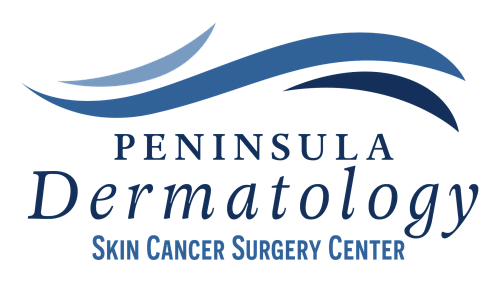MEDICAL DERMATOLOGY
We offer a wide range of medical services for treating a wide variety of skin problems.
MEDICAL DERMATOLOGIC SKIN CONDITIONS WE TREAT
At Peninsula Dermatology Skin Cancer Surgery Center, we evaluate and treat people of all ages, including infants and children.
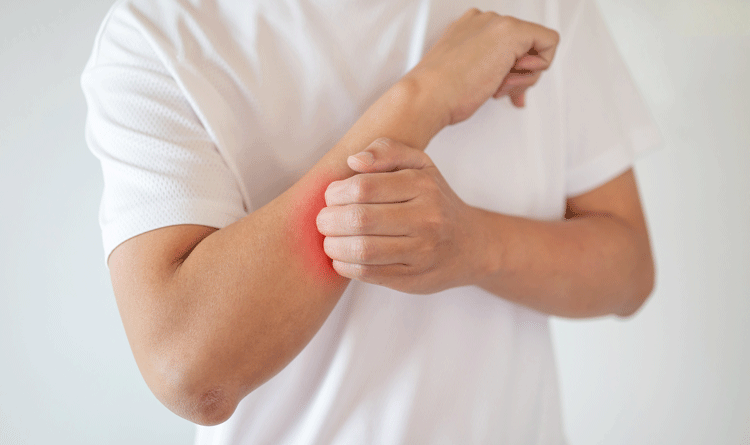
- Acne
- Allergic contact rashes
- Atypical Moles/Nevi
- Autoimmune diseases affecting the skin
- Dandruff/Seborrheic dermatitis
- Dry Skin
- Eczema/Atopic Dermatitis
- Excessive Sweating/Hyperhidrosis
- Full body skin exams
- Fungal Infections
- Hair loss/Alopecia
- Hives
- Itch
- Melasma
- Mycosis Fungoides/ Cutaneous T cell lymphoma
- Nail conditions
- Psoriasis
- Rashes
- Rosacea
- Shingles
- Skin Cancer Screening and Prevention
- Skin care and anti-aging recommendations
- Vitiligo
- Warts
Need treatment for a skin condition not listed above? Chances are if it’s related to your skin, we can help diagnose and treat it!
COMMON SKIN CONDITIONS EXPLAINED
What is Rosacea?
Rosacea is a common and chronic inflammatory skin disorder that primarily affects the facial skin and is most likely to occur after the age of 30. Rosacea is described as a redness on the cheeks, nose, chin or forehead. Over time, the redness tends to become deeper in color and more persistent with visible blood vessels. If untreated, bumps and pimples can develop and in some cases the nose becomes swollen and uneven from excess tissue. Rosacea symptoms tend to come and go as the condition can flare for a few weeks and then fade.
Causes of Rosacea
There are many theories as to the causes of rosacea, however the true cause is not yet fully known. Studies have shown that rosacea may be caused by a combination of hereditary and environmental elements. Rosacea is not caused by poor hygiene. Rosacea can be triggered by a number of factors, such as:
- Hot drinks
- Spicy foods
- Red wine and other beverages containing alcohol
- Extreme temperature changes
- Wind
- Sunlight exposure
- Exercise
- Cosmetics
- Medications including blood pressure medications that dilate the blood vessels
Symptoms of Rosacea
Rosacea can affect anyone, but it most commonly affects middle-aged women who have a light skin complexion. Rosacea may be mistaken for acne or other skin problems therefore it is important to see a dermatologist to get the proper diagnosis and treatment. :
- Flushing – Patients with rosacea typically have a history of ease of blushing or flushing (with temperature change or light activity). This may come and go, but is often one of the earliest signs of the skin disorder.
- Facial redness – Redness that will not dissipate and may be mistaken for a sunburn is the most common symptom of rosacea. The small blood vessels on your nose and cheeks swell and become visible. The skin may feel warm and slightly tender.
- Swollen red bumps and/or pimples – Often small, solid red bumps will develop and/or pimples, which may be mistaken for acne. These bumps generally cause soreness.
- Visible Blood Vessels – Some patients will have tiny, but visible, blood vessels appear as a result of the skin disorder.
- Eye problems – Often one of the first symptoms of the condition is dry, irritated, swollen eyes or eyelids and this is known as ocular rosacea.
- Enlarged nose – An enlarged nose may occur after many years of having rosacea and is a result of a thickening of the skin on the nose due to persistent swollen blood vessels. This happens more often in men than women.
Additional signs and symptoms include:
- Eye irritation
- Burning
- Stinging
- Dry appearance
- Raised red patches (called plaques) may develop in surrounding skin
- Thickening of the skin, most frequently on the nose
- Facial swelling or edema
- Extension of symptoms to include the neck, chest, scalp or ears
Diagnosing Rosacea
At Peninsula Dermatology Skin Cancer Surgery Center, we specialize in diagnosing and treating skin conditions like rosacea. Your diagnosis will depend on the history of your symptoms, family history and a thorough skin examination. The dermatologist may want to run additional tests to rule out other diseases that can cause symptoms similar to rosacea. Depending on the severity of your symptoms, it is important to get an accurate diagnosis so you can begin treatment for rosacea. Even though there is no cure for rosacea, the symptoms can be managed and the appearance of your skin will improve.
Treatment for Rosacea
Just as the signs and symptoms are different from person to person, the treatment plan must be tailor-made by a dermatologist to meet the needs of each individual. Our board certified dermatologist will evaluate your skin condition and prescribe a medical dermatology regimen that will help bring the symptoms of rosacea under control. The treatment may include a combination of oral and topical therapy, followed by a topical treatment to maintain the gains achieved by the initial therapy.
Laser treatment, utilizing a pulsed light source, is an option to reduce or eliminate visible blood vessels associated with rosacea. Light therapy has been shown to reduce redness.
At Peninsula Dermatology Skin Cancer Surgery Center located in Newport News and Williamsburg, VA, we encourage patients to adopt self-care practices that can be done at home to reduce rosacea flares, including:
- Protect face by always wearing sunscreen and hats
- Identify and avoid triggers
- Treat skin gently – do not scrub it or use harsh products such as alcohol to cleanse it.
- Use gentle cosmetics to reduce the appearance of redness
It is prudent to discuss your skincare regimen with your dermatologist to make sure it is compatible with your rosacea therapy. Gentle cleansers, lukewarm water and non-abrasive cloths should be used to blot your face after your cleaning regimen.
Eczema is a condition that causes skin to become inflamed, red and itchy. Atopic dermatitis (AD), also known as eczema, is a common skin disease in children and some adults. Eczema is often accompanied by allergies and/or asthma. Depending on the severity, eczema can produce quite a bit of discomfort for its sufferer. The skin may become itchy, dry and form scaly raised patches. In babies, atopic dermatitis can appear on the cheeks, face and scalp. It is important to keep these patches of skin clean as they can be prone to infection.
As children age, the scaly patches of atopic dermatitis can appear on:
- The backs of knees
- Fingers, knuckles and nail beds
- Inside elbow creases
- Ankles
- Wrists
In time, the skin with atopic dermatitis can thicken, lighten or darken. Itching, especially in children, is a concern with eczema as it can lead to skin infections. While there is no cure for eczema, it can be managed with self-care measures at home. It will help to avoid chemicals and harsh soaps. Frequently moisturizing skin and applying medicated creams or ointments can reduce the inflammation and itching.
Causes of Atopic Dermatitis/Eczema
It is believed that many factors play a role in causing eczema, such as an overactive immune response to an irritant. Family history, asthma, environmental allergies, food allergies, cold temperatures and animal dander are also suspected causes of eczema. Once you can identify a trigger for an eczema flare, you can help manage the symptoms by avoiding triggers in the future.
Symptoms of Atopic Dermatitis/Eczema
As with most skin conditions, the symptoms can vary from person to person, however one of the primary symptoms of atopic dermatitis is itching. The itching can be so severe that it causes people to scratch it even until it bleeds. This is known as the itch-scratch cycle and breaks in the skin increase the chances of infection. Other symptoms of eczema include:
- Dry, sensitive skin
- Inflamed, red skin
- Severe itching
- Darker or colored patches of skin located on the:
- Hands
- Feet
- Wrists
- Ankles
- Crease of elbow
- Behind the knees
- Face
- Scalp
- Upper chest
- Eyelids
- Knuckles and nail beds
- Scaly patches of skin that feel rough or leathery
- Oozing and crusting over
- Swelling in affected areas
Some people may have all of these symptoms and others only a few. The way to truly determine if you have atopic dermatitis is to see a dermatologist. Our board certified medical dermatology physicians at Peninsula Dermatology Skin Cancer Surgery Center specialize in diagnosing and treating atopic dermatitis. If you are suffering with any of the symptoms listed above, please call Peninsula Dermatology Skin Cancer Surgery Center today at (757)873-0161.
Diagnosing Atopic Dermatitis/Eczema
If you or your child is struggling with chronic eczema or eczema flares, contact Peninsula Dermatology Skin Cancer Surgery Center today. At Peninsula Dermatology Skin Cancer Surgery Center, our board certified dermatologists are experts in diagnosing and treating atopic dermatitis. To diagnose eczema, we will review your medical history and perform a skin examination to identify the areas of skin affected by eczema. Generally, additional tests are not needed to diagnose eczema, however your doctor may want to do patch testing to rule out other skin conditions. Patch testing is used to discern the main allergens to which the child or adult is reacting.
Treatment for Atopic Dermatitis
While there is no cure for atopic dermatitis, treating it can help to control the severe itching and prevent flare-ups. Treating eczema is important because it can:
- Prevent it from getting worse
- Relieve pain or itching, thus calming the skin
- Reduce the risk of and possibly prevent skin infections
- Reduce the thickening of the skin often caused by eczema
The treatment plan for atopic dermatitis includes anti-inflammatory topical medicine, daily skin care and lifestyle modifications. Skin care and lifestyle changes can reduce or prevent the amount of flare-ups. At Peninsula Dermatology Skin Cancer Surgery Center, we will create a tailored treatment plan to help you control your eczema. Our goals include:
- Control itching
- Reduce skin inflammation (redness and swelling)
- Clear any infections that may be present
- Loosen and remove scaly lesions, when necessary
If needed, there are oral medications that can be prescribed to fight infection and control inflammation. For severe cases of eczema that do not respond to medications, the simplest form of light therapy, known as phototherapy, has been successful in controlling symptoms in adult patients.
What is Psoriasis?
Psoriasis is a chronic skin condition that is characterized by skin cells that multiply at a much faster rate than normal skin cells. In healthy skin, the underlying epidermal cells reach the skin’s surface and die. With the increased volume of dead skin cells in patients suffering with psoriasis, the cells that would normally slough off become raised, red plaques covered with whitish scales. The red, patchy scales are itchy and sometimes painful. Psoriasis is a medical dermatology condition that typically occurs on the knees, elbows and scalp; however, it may affect other areas of the body.
The most common type of psoriasis is plaque psoriasis, however there are several types of psoriasis that include:
- Nail psoriasis
- Guttate psoriasis
- Inverse psoriasis
- Pustular psoriasis
- Erythrodermic psoriasis
- Psoriatic arthritis
Cause of Psoriasis
The exact cause of psoriasis is currently unknown. Several factors are considered to be potential causes of psoriasis including: genetics, environmental triggers and the immune system. Researchers believe it may be an autoimmune response within the body that causes the skin cells to become inflamed and work in overdrive. No doubt, psoriasis is an irritating skin disorder that can cause discomfort and anxiety for the person who has it.
As with other skin conditions that are chronic, psoriasis typically starts or worsens due to exposure to a trigger. Some common triggers can be:
- Infections, strep throat or skin infections
- Stress
- Smoking
- Heavy alcohol consumption
- Injury to the skin such as a cut or a scrape
- Severe sunburn
- Vitamin D deficiency
- Certain prescription medications
Symptoms of Psoriasis
Psoriasis symptoms are unique to each individual and vary in severity. Common signs and symptoms of psoriasis include:
- Red patches of skin covered by thick white or silvery scales
- Cracked, dry skin that may or may not bleed
- Small scaly spots (children)
- Thickened, pitted or ridged nails
- Swollen and stiff joints
Plaque psoriasis can develop anywhere on the body, but the most common locations include:
- Face
- Scalp
- Neck
- Hands
- Feet
- Elbows
Diagnosing Psoriasis
The board certified dermatologists at Peninsula Dermatology Skin Cancer Surgery Center located in Newport News, VA are skin specialists and have extensive training in diagnosing and treating psoriasis. Our dermatologists will perform a thorough examination of your skin to make an accurate diagnosis of psoriasis. We will also discuss your health history and determine if any other family members have the condition. Occasionally, the dermatologist may want to confirm the diagnosis through a small biopsy, which can be done in the office on the day of your appointment.
Treatment for Psoriasis
At Peninsula Dermatology Skin Cancer Surgery Center, we will partner with you in determining the best treatment options for your unique symptoms of psoriasis. Although there is no cure for psoriasis, treatment can provide relief during flare-ups. Treatment options aim to reduce inflammation, slow the growth of skin cells and reduce plaques. The options include:
- Topical creams or ointments applied directly into the affected skin can provide relief for mild to moderate psoriasis without using the systemic oral medication. Topical treatments include:
- Steroid-based creams to decrease inflammation, decrease production of cells and relieve itching.
- Salicylic acid in ointment form to smooth the skin by promoting the shedding of psoriatic cells.
- A Vitamin D topical ointment, which has been proven to be highly effective, especially when combined with a topical corticosteroid cream.
- Prescription retinoids are topical preparations that contain synthetic forms of Vitamin A, helping to improve psoriatic conditions.
- Systemic medications can be prescribed for moderate to severe psoriasis or for those whose psoriasis did not respond to topical treatment.
- UV or natural light therapy has proven effective in treating psoriasis by killing the overactive white blood cells that attack healthy skin cells
At Peninsula Dermatology Skin Cancer Surgery Center, we will help you manage the discomfort of psoriasis. Our dermatologists are compassionate towards patients with skin conditions that affect their self-esteem and quality of life. If you suspect that you have psoriasis and it is causing you discomfort or pain, call Peninsula Dermatology Skin Cancer Surgery Center at (757)873-0161. We offer tailored treatments that will be most effective for you in the management of psoriasis.
When your skin comes in contact with an irritant or an allergen, it can cause a reaction known as contact dermatitis. This reaction can include symptoms such as:
- Rash
- Blisters
- Itching
- Burning
- Hives
Allergens and irritants are unique to each person. Triggers for some people are harmless to others. People who have allergies also have immune systems that tend to overreact to allergens. The immune system believes it is under attack and creates a surge of antibodies to help fight the attack. These antibodies result in a red, itchy rash.
Common Causes of Skin Allergies
It may take years to develop skin allergies, and people are often surprised to learn that they become increasingly sensitive to animals, fragrances, chemicals, and other environmental agents as they age. Common skin allergies include:
- Nickel – a metal used in money, jewelry, makeup, lotions, soaps and shampoos
- Sunscreens and bug spray
- Fragrances
- Cleaning products
- Plant – such as poison ivy and poison oak
- Latex – used in gloves and some clothing
- Chemicals
- Pollen
- Cigarette smoke
It is also possible to develop skin allergies by eating food that you are allergic to. You may not know that you have become allergic to certain foods and you can develop hives or eczema as a result. The most common foods that cause allergic skin reactions are:
- Nuts
- Fish
- Eggs
- Fresh fruit and vegetables
- Soy
- Wheat
- Milk
- Food additives or dyes
Hives
Hives are described as itchy, red welts that appear after exposure to an allergen. Hives are extremely itchy and they can range in size from small – such as a pencil eraser to large – the size of a dinner plate. Hives can last for hours or days depending on the cause and how you treat them. Occasionally, viral illnesses may also cause hives.
Diagnosing Skin Allergies and Contact Dermatitis
At Peninsula Dermatology Skin Cancer Surgery Center, located in Newport News, VA, we can help you identify the triggers that may be causing your allergic skin reactions. However, the best information comes from you and your symptoms. If you are experiencing allergic skin reactions such as hives, we encourage you to keep a journal of any irritants or foods that you may have been exposed to that could be triggering the allergy.
If it is unclear or seems the allergic reactions are random, our board certified dermatologists can offer patch testing to help diagnose skin allergies. In patch testing, the most common irritants and allergens are applied to the skin on the back and left for a period of time. Afterwards, the skin is examined to determine which allergen you are reacting to.
In the case of food allergies, a blood test known as a RAST (radioallergosorbent test) can be given to check the blood for specific IgE antibodies, which are present when you are allergic to foods or environmental substances.
Treating Skin Allergies and Contact Dermatitis
The best way to treat skin allergies, contact dermatitis and hives is by avoiding the trigger. If we can identify the allergies, then you can make every effort to avoid them in the future. If you are exposed to an allergen, your doctor may recommend an oral antihistamine medication to calm the reaction. There are also topical steroid creams that can help combat the itchiness of contact dermatitis. If you are experiencing skin allergies and symptoms of contact dermatitis, call Peninsula Dermatology Skin Cancer Surgery Center today at (757)873-0161 so we can help you identify your triggers and create a medical dermatology treatment plan to help you manage the allergic reactions.
Shingles
Shingles is a painful skin rash that is caused by the varicella zoster virus, also known as herpes zoster. If you had chickenpox as a child, then you have the virus that causes shingles lying dormant in the nerve tissue near the spinal cord. Years later, the virus can reactivate as shingles. Shingles most commonly occurs in older adults and people who have weakened immune systems due to stress, injury, illness or medications.
Shingles usually appear on one side of the body along the path of one of the spinal nerves. These nerves branch from the spine to the intercostals or rib cage. It may also occur along the path of the facial nerves on one side of the head, possibly near the eye.
Cause of Shingles
When you are exposed to the varicella zoster virus, usually as a child, it causes chickenpox. As the chickenpox runs its course, the virus moves into the nerve tissue near the spinal cord where it will stay for many years. It is unclear the exact reason, but the virus can reactivate or ‘wake up’ later in life, traveling along the nerve fibers from the spine and becoming shingles. There are risk factors that increase the chances of shingles, such as:
- Being over the age of 50
- Stress
- Cancer, or other diseases that weakens the immune system
- Physical injuries
- Certain medications that also weaken the immune system
Many people get shingles that do not have these risk factors. Although most people get shingles only once, it is possible to get it two or more times in life.
Symptoms of Shingles
Shingles develops in stages. Shingles runs a course that can last anywhere from ten days to a month. It typically begins with a localized itching, tingling, burning or prickly pain sensation that wraps around the left or right side of your torso. However, shingles can appear in the scalp, around the orbit of an eye, face, neck and other places on the body. You may experience flu-like symptoms, but not have a fever. In a few days, shingles will progress through an itching, tingling or burning phase in a certain area. Within several more days, a rash may occur turning into clusters of blisters. The blisters fill with fluid and then crust over, taking approximately 2 to 4 weeks to completely heal. Residual nerve pain, also known as postherpetic neuralgia, is not uncommon in cases of shingles. The pain may be intense and require pain management to bring it under control.
Diagnosing Shingles
Shingles is usually diagnosed by the blistery, itching, painful rash that crusts over in a few days. The doctor will be able to determine it is shingles based on a visual inspection of the location of the rash and the symptoms you are experiencing. At Peninsula Dermatology Skin Cancer Surgery Center, our board certified dermatologists are experts in diagnosing shingles. If you are experiencing the symptoms of shingles, call us Peninsula Dermatology Skin Cancer Surgery Center today (757)873-0161.
Treatment and Prevention for Shingles
Shingles is treated with prescription antiviral medications. The sooner the antiviral medicine is started, the faster your rash will heal and become less painful. You may need to take an over-the-counter pain reliever to combat the discomfort associated with shingles.
Currently, a vaccine is offered to everyone over the age of 50 to prevent or make a future shingles event less painful. Contact your doctor to find out if you are a candidate for the shingles vaccine.
Common Warts
Small, rough and grainy, common warts are caused by the human papillomavirus (HPV) and can be transmitted by skin-to-skin contact. As the virus comes in contact with the outer layer of skin, through small breaks in the skin, it causes the rapid growth of cells in that area – creating a wart. Children and young adults are more likely to have common warts, as are people with weakened immune systems. Common warts usually appear on hands, fingers and sometimes the arms.
Causes of Warts
Any break in the skin, no matter how small, even dry skin that is irritated, can create an avenue for the wart causing virus to enter. The virus may lay dormant in the skin for some time before it becomes a wart. People usually contract the HPV virus from skin to skin contact with other people who have a wart/s. The virus may also be passed through shared towels, shared sports equipment and even doorknobs. Some people are more susceptible to the virus than others and it is common to see warts run in families.
Symptoms of Common Warts
Warts that occur on the hands or fingers can be:
- Small, flesh-colored, slightly raised bump
- White, pink or tan
- Rough or scaly to the touch
- Contain small black pinpoints, which are clotted capillaries
Diagnosing Common Warts
Most people know when they have a wart and then make a medical dermatology appointment with us for treatment. At Peninsula Dermatology Skin Cancer Surgery Center, we believe it is safe to use over-the-counter wart treatments at home as long as you follow the directions closely and understand that it may take several weeks to several months for the entire wart to go away.
Treatment of Warts
Most common warts will go away on their own without treatment; but it might take a couple of years, and it could spread to new areas nearby. The goal of treatment is to eradicate the wart or stimulate the immune system to fight the virus on its own. Peninsula Dermatology Skin Cancer Surgery Center begins with the least painful and invasive approach to eliminate the wart. Dermatologic treatment options for eliminating warts include:
- Salicylic acid. Prescription strength topical wart medication that removes the wart layer by layer.
- Freezing (cryotherapy). Freezing therapy for wart removal utilizes the application of liquid nitrogen to kill the wart. This method of wart elimination is also a way to stimulate your body’s immune system to fight the virus causing the wart.
- Bichloroacetic or trichloroacetic acid. Other acids can be used if salicylic acid or freezing does not work.
- Laser treatment. Utilizing a pulsed-dye laser, the heat will cauterize tiny blood vessels causing the wart to lose its blood supply and die. This method is not widely used, as it can cause scarring.
Wart Prevention
There are some ways to reduce the risk of getting warts such as:
- Wash hands thoroughly and regularly especially when leaving a gym
- Avoiding direct contact with warts including your own
- Avoid picking the wart as this may cause it to spread
- Do not bite your fingernails as warts occur more often in skin that is broken
- Try to keep your skin as healthy as possible by minimizing cuts, fissures and openings by which the virus can enter
Hair Loss
Hair loss is a medical dermatology condition that may also be referred to as male-pattern baldness, female-pattern baldness and androgenetic alopecia. It is normal to lose approximately 50-100 hairs a day. The most common cause of hair loss is hereditary hair loss, occurring in millions of men and women. Fortunately, most hair loss can be stopped or treated successfully. If you are experiencing abnormal hair loss or hereditary hair loss, a dermatologist is the best place to start. At Peninsula Dermatology Skin Cancer Surgery Center, we offer many effective treatments for hair loss.
Causes of Hair Loss
While there are many conditions that can cause hair loss, the most common cause is heredity. Underlying medical conditions can also cause hair loss, and may even be the first sign of a disease. Several medical issues can contribute to loss of hair. Treating the disease will stop the hair loss.
Poor nutrition and diet is another reason people experience hair loss. Weight loss of 15 or more pounds can trigger hair to fall out; however, the hair will eventually regrow without treatment. Too much Vitamin A can cause hair loss, as well as too little protein. Additional causes of hair loss include:
- Hormonal changes such as after pregnancy and menopause
- Radiation therapy to the head
- Stress
- Certain hairstyles such as wearing heavy extensions or hair pulled to tight can inflame the hair follicles and cause scarring and hair loss
Symptoms of Hair Loss
Hair loss can occur in many different ways. It can happen suddenly or gradually over time. Some hair loss is temporary while other loss is permanent. Some signs and symptoms of hair loss are:
- Gradual thinning – occurs in men and women as they age
- Patchy or circular bald spots
- Sudden loose hair – may be seen with emotional stress
- Full body hair loss – occurs in patients undergoing chemotherapy and usually grows back
- Patches of scaling on scalp – may be caused by a fungus such as ringworm
Diagnosing Hair Loss
At Peninsula Dermatology Skin Cancer Surgery Center located in Newport News, VA, our board certified dermatologists are highly knowledgeable and trained in the latest advancements for hair loss. If your hair has been thinning, falling out or you are experiencing hair loss that is concerning you, call us today for an appointment (757)873-0161.
To ensure an accurate diagnosis, we will perform a thorough examination of your scalp and hair as well as discuss your health history and family health history. An accurate diagnosis will confirm that the exact cause of your hair loss is being addressed. We may offer some blood tests that can help identify conditions related to hair loss. If needed, we can scrape a small sample of the skin from the scalp to determine if you have an infection that is causing the hair loss.
Treatment for Hair Loss
After the examination, Peninsula Dermatology Skin Cancer Surgery Center will be able to offer treatment options that can help reverse hair loss or slow the rate of hair loss. In some cases, changing hair products may be all you need to stop hair loss.
There are many treatments available to slow hair loss. Over-the-counter medication, such as minoxidil, is generally a first-line treatment. Prescription medicine is available in pill form to treat hair loss in men.
Skin Conditions of the Scalp
There are many skin conditions that can affect the scalp causing itching, irritation and possibly hair loss. Most of the treatments for scalp conditions are topical, such as medicated shampoos. Some skin conditions of the scalp include:
- Dandruff – dry flakes of skin on the scalp which is a build up of dead skin cells that eventually flake off
- Seborrheic Dermatitis – is a more severe form of dandruff and may cause the scalp to redden and produce extra oil. This condition is more common in people who have oily skin or hair, acne or psoriasis
- Folliculitis – is infection or inflammation in the hair follicle that contains the root of the hair. It can be caused by shaving, but it usually goes away on its own. For more severe cases, proper treatment with an antibiotic will clear folliculitis
- Psoriasis – this skin condition can appear anywhere on the skin including the scalp. The crusty scales that come from psoriasis can be particularly irritating on the scalp and ay need to be treated with steroid creams, medicated shampoos and even UV light therapy
- Tinea capitis – is a fungal infection that affects the scalp and hair shafts. It can appear in flaky patches that are itchy and cause hair loss, scalp pain and other symptoms
- Alopecia areata – is a skin condition that causes hair loss to appear randomly over the scalp. This type of hair loss is not often permanent and may take a while to grow back
Autoimmune disease can affect any part of the body including the skin. Often autoimmune disease will affect more than one part of the body as well as the skin.
What is Mycosis Fungoides?
Mycosis Fungoides, also known as cutaneous T-cell lymphoma, is a form of blood cancer that affects the skin. It occurs when white blood cells, known as T-cells, grow at a rapid pace and move from the blood into the skin. Cutaneous T-cell lymphoma can cause a reddish rash with slightly raised or scaly round patches on the skin that can be quite itchy. Mycosis fungoides is the most common type of T-cell lymphoma and generally occurs in adults over the age of 50.
Cause of Mycosis Fungoides
The exact cause of mycosis fungoides is unknown; however, T-cells are part of the immune system. When T-cells become cancerous due to possible DNA mutations, cutaneous T-cell lymphoma can occur. Then the abnormal T cells attack the skin. Other factors like environmental exposures and particular bacterial or viral infections may contribute to the cause of mycosis fungoides, but these factors and how they affect the development of this cancer remain unclear.
Symptoms of Mycosis Fungoides
Mycosis fungoides can progress slowly through four stages, but not all individuals affected will progress through all of the stages. The phases are as follows:
- First Phase – scaly, reddish, itchy rash usually occurring in areas that are not exposed to sunlight – this stage may last many months and even years
- Second Phase – thin, lighter colored rash that looks like patches forming typically on the upper thighs, buttocks and breasts. These patches can remain stable over time or come and go
- Third Phase – plaques, raised lesions that can be itchy, reddish, purple or brown form in the same body regions
- Fourth Phase – lumps or raised nodules that form on the skin and may break open and become infected
Within these phases patients may also experience enlarged lymph nodes, hair loss, thickening of the skin on the palms and soles of feet and an itchy, reddish rash over the entire body.
Diagnosing Mycosis Fungoides
If your doctor suspects your medical dermatology skin conditions are related to cutaneous T-cell lymphoma, you can expect several tests to be performed to ensure an accurate diagnosis. The symptoms of mycosis fungoides can often resemble other skin conditions; therefore, it is imperative that thorough testing be done so treatment can begin as soon as possible. Your dermatologist will perform a complete physical examination inspecting all of the areas of skin that are affected. Sometimes, cancer cells are found in the blood and so you will receive blood work to help confirm a diagnosis. Skin biopsies, a procedure used to remove a small portion of skin, will need to be examined by a pathologist under advanced laboratory testing. Lastly, imaging tests, such as a CT scan or a PET scan, will be ordered to determine if the cancer has spread into other parts of the body.
At Peninsula Dermatology Skin Cancer Surgery Center, we will partner with you and your oncologist to formulate the best treatment plan.
Treatment for Mycosis Fungoides
The treatment options for mycosis fungoides will depend on the stage of disease. Cutaneous T-cell lymphoma is rarely cured; however, it is a manageable disease that can stay in remission for long periods of time. It is common to use a combination of therapies to treat this illness. Treatment options may include:
- Ointments and creams for the skin – corticosteroid creams can help relieve the itching and redness. Topical chemotherapy creams can be used to attack the cancer cells
- Phototherapy – utilizes UVA and UVB light waves after the application of a medicine that increases the skin cells sensitivity to light. The goal of this treatment is for healthy skin cells to regenerate quickly
- Radiation therapy – can be used to target specific affected areas of the skin or the entire body without affecting the internal organs
- Medications – depending on the specific type of cancer, chemotherapy medicines can attack the rapidly growing cancer cells
- Photopheresis – after taking a special medication that makes your blood cells more sensitive to light, this procedure exposes the blood cells to UV rays through a special machine that takes out the T-cells. This test may be reserved for more advanced cases of mycosis fungoides
Bone marrow transplant – replaces diseased bone marrow with healthy donor bone marrow to help rebuild healthy blood cells
MEDICAL DERMATOLOGY THERAPIES OFFERED IN OUR OFFICE
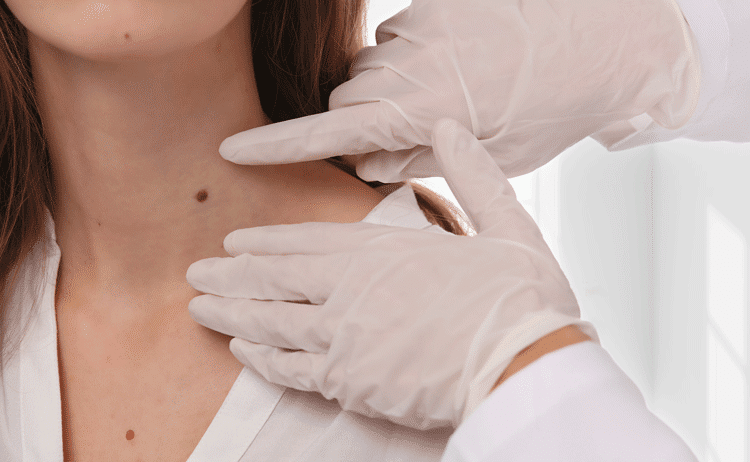
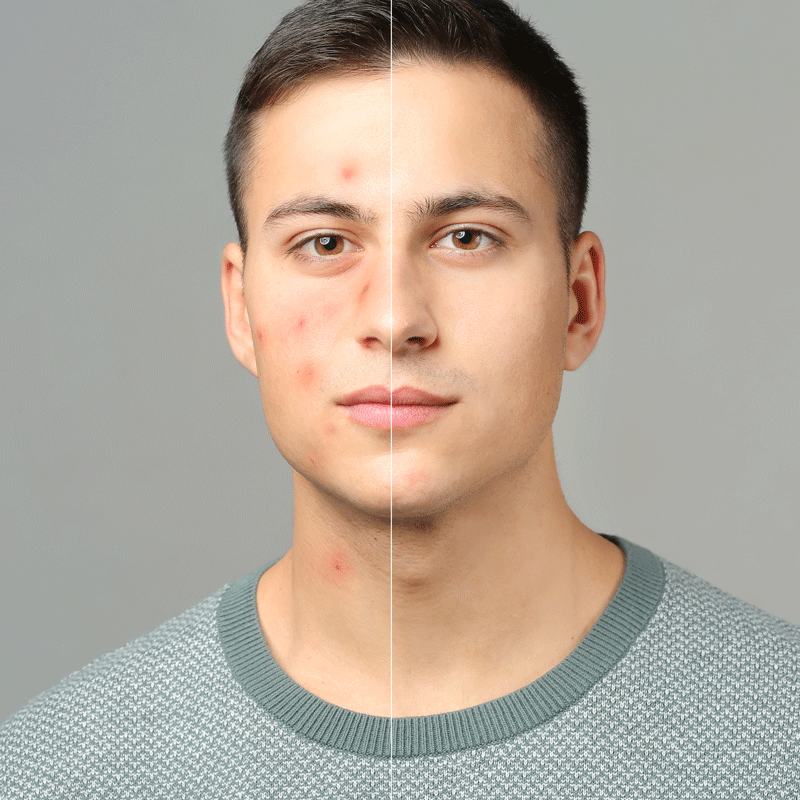
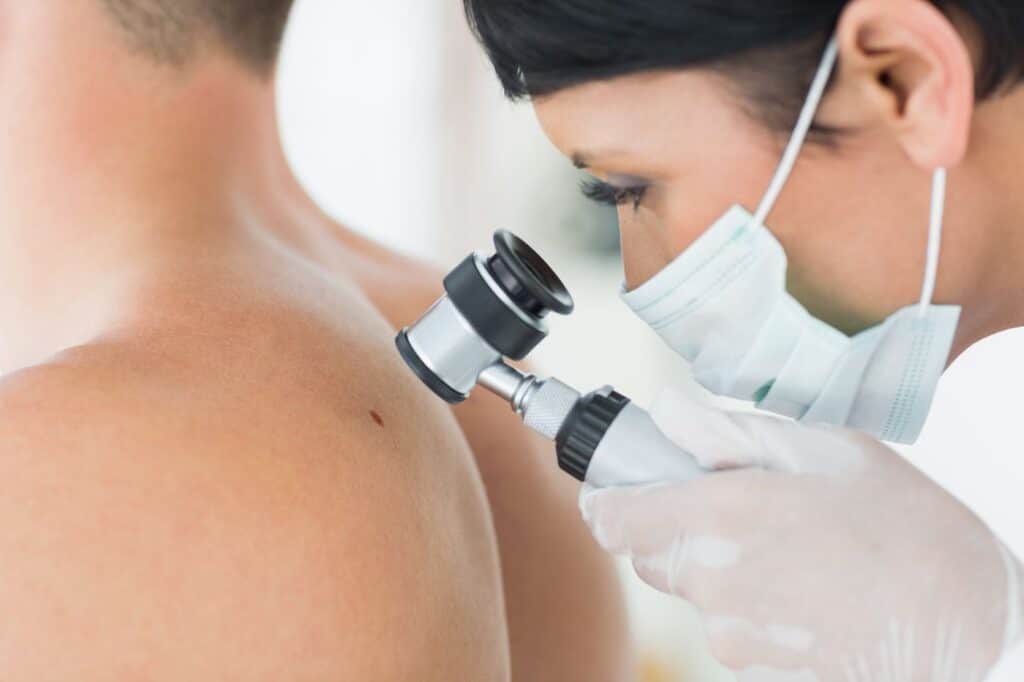
ADVANCED TOTAL BODY MOLE MAPPING
Mole mapping, or SkinIO, is a skin health monitoring system that aims to identify changes in the skin and detect changes early by having a digital image record. This monitoring technology is on the forefront of early skin cancer detection. (Learn More)
NARROW BAND UVB
Our state-of-the-art technology includes using Narrow Band UVB Photo-therapy for the treatment of psoriasis, eczema, vitiligo and cutaneous lymphoma, as well as photodynamic therapy for sun damaged skin and precancerous keratosis. (Learn More)
PHOTODYNAMIC THERAPY/ BLUE-LIGHT
We offer photodynamic therapy which is a two stage treatment for destroying cancerous and precancerous cells.For adults that have acne, newer therapies that include the use of lasers and photodynamic light have been successful. (Learn More)
PATCH TESTING EXTENDED SERIES
Your doctor may want to do patch testing to rule out other skin conditions. Patch testing is used to discern the main allergens to which the child or adult is reacting.
GENETIC TESTING
Surgery Center offers genetic testing using Castle Biosciences and DermTech products. DecisionDX Genetic Testing from Castle Biosciences helps predict the risk of recurrence or metastasis of melanoma. (Learn More)
DERMOSCOPY
A widely used non-invasive diagnostic tool, the dermoscope illuminates and magnifies skin lesions allowing the dermatologist to observe and analyze without obstruction. (Learn More)
REQUEST AN APPOINTMENT WITH OUR SKILLED DOCTORS TODAY
We deeply value the relationships we create with our patients and look forward to caring for you and your family.
NEWPORT NEWS
LOCATION

11844 Rock Landing Drive, Suite B
Newport News, VA 23606
Phone: (757) 873-0161
Fax: (757) 873-0205
WILLIAMSBURG
LOCATION

475 McLaws Circle,
Suite One
Williamsburg, VA 23185
Phone: (757) 259-9466
Fax: (757) 259-7907
OFFICE
HOURS

Monday-Thursday:
7:30am-5pm
Friday:
7:30am-4pm
